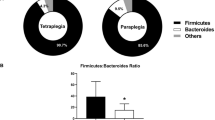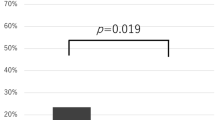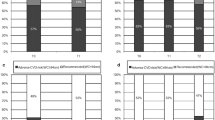Abstract
Background/Objectives:
A disease-specific nutrition screening tool (NST): the spinal nutrition screening tool (SNST) has been developed for use in patients with spinal cord injury (SCI) but its reliability and agreement with other published tools requires investigation. The aims of this study were to assess the prevalence of malnutrition risk in SCI patients and to confirm the diagnostic accuracy of the SNST.
Subjects/Methods:
Patients’ baseline clinical data, anthropometric measurements and NST scores were assessed. The validity of the SNST was assessed by (i) comparing with a full dietetic assessment (criterion validity); (ii) comparison with a generic NST: malnutrition universal screening tool (MUST) (concurrent validity); and (iii) completion of an additional SNST to assess inter- and intra-rater reliability. Agreement was assessed using Cohen's κ-statistics.
Results:
Using the SNST, the prevalence of malnutrition risk ranged from 22 to 64% on admission to four SCI centres. The SNST had substantial agreement with MUST (κ: 0.723, 95% confidence interval (CI): 0.607–0.839) and dietitian assessment (κ: 0.567, 95% CI: 0.434–0.699). The SNST had a moderate to substantial reliability (inter-rater reliability: κ: 0.5, 95% CI: 0.2–0.8; intra-rater reliability: κ: 0.64, 95% CI: 0.486–0.802). When compared with dietetic assessment, the SNST had a numerically lower specificity (76.1% vs 80.4%) and similar agreement to MUST (κ: 0.57 vs 0.58) but SNST showed a numerically higher sensitivity (85.7% vs 80.4%) and a numerically higher negative predictive value (92% vs 89.2%) than MUST.
Conclusions:
This study shows that malnutrition is common in SCI patients. The SNST is an acceptable (valid and reliable) NST and may be a useful alternative to MUST in identifying SCI patients at risk of malnutrition.
This is a preview of subscription content, access via your institution
Access options
Subscribe to this journal
Receive 12 print issues and online access
$259.00 per year
only $21.58 per issue
Buy this article
- Purchase on Springer Link
- Instant access to full article PDF
Prices may be subject to local taxes which are calculated during checkout

Similar content being viewed by others
References
American Dietetic Association (2009). Spinal cord injury (SCI) Evidence-based nutrition practice guideline. www.adaevidencelibrary.com, assessed 16 April 2010.
British Dietetics Association (1999). Nutrition Screeing Tools. Professional Development Committee Briefing Paper no.9. BDA: Birmingham.
Brotherton A, Simmonds N, Stroud M (2010). Malnutrition Matters: Meeting Quality Standards in Nutritional Care. BAPEN: Redditch Worcs.
Elia M (2003). Screening for Malnutrition: A Multidisciplinary Responsibility. Development and Use of the Malnutrition Universal Screening Tool (MUST) for Adults. BAPEN: Redditch Worcs. http://www.bapen.org.uk/pdfs/must/must_full.pdf, assessed 10 July 2011.
Gerasimidis K, Drongitis P, Murray L, Young D, McKee RF (2007). A local nutritional screening tool compared to malnutrition universal screening tool. Eur J Clin Nutr 61, 916–921.
Groah SL, Nash MS, Ljungberg IH, Libin A, Hamm LF, Ward E et al. (2009). Nutrient intake and body habits after spinal cord injury: an analysis by sex and level of injury. J Spinal Cord Med 32, 25–33.
Kubrak C, Jensen L (2007). Malnutrition in acute care patients: a narrative review. Int J Nus Stud 44, 778–784.
Landis JR, Koch GG (1977). The measurement of observer agreement for categorical data. Biometrics 33, 159.
Laughton GE, Buchholz AC, Martin Ginis KA, Goy RE (2009). Lowering body mass index cutoffs better identifies obese persons with spinal cord injury. Spinal Cord 47, 757–762.
Liusuwan A, Widman L, Abresch RT, McDonald CM (2004). Altered body composition affects resting energy expenditure and interpretation of body mass index in children with spinal cord injury. J Spinal Cord Med 27 (Supp1), S24–S28.
MASCIP (Multidisciplinary Association for Spinal Cord Injury Profession) (2010). Guidelines on Rehabilitation of Older Adult with Spinal Cord Injury. http://www.mascip.co.uk/Core/DownloadDoc.aspx?documentID=5100, assessed 16 January 2011.
NHS Institute for Innovation and Improvement (2009). High Impact Actions for Nursing and Midwifery. http://www.institute.nhs.uk/images//stories/Building_Capability/HIA/NHSI%20High%20Impact%20Actions.pdf, accessed 17 January 2011.
NICE (2006). Nutrition Support in Adults: Oral Nutrition Support, Enteral Tube Feeding and Parenteral Nutrition. NICE: London. http://www.nice.org.uk/nicemedia/live/10978/29981/29981.pdf, accessed 10 July 2011.
Stratton RJ, Hackston A, Longmore D, Dixon R, Price S, Stroud M et al. (2004). Malnutrition in hospital outpatients and inpatients: prevalence, concurrent validity and ease of use of the ‘malnutrition universal screening tool’ (MUST) for adults. Br J Nutr 92, 799–808.
Tammam JD, Gardner L, Hickson M (2009). validity, reliability and acceptability of the Imperial Nutritional Screening System (INSYST): a tool that does not require the body mass index. J Hum Nutr Diet 22, 536–544.
Wong SS, Derry F, Sherrington K, Gerogery G (2009). An audit to evaluate the use of nutrition screening tool in the National Spinal injury centre, stoke mandeville hospital, buckinghamshire hospitals NHS trust. Proc Nutr Soc 68, E53.
Wong SS, Derry F, Forbes A, Grimble G, Reilly JJ, Gandy J (2010a). Association of nutrition risk score and nutritional indices in patients with spinal cord injuries – the result form a UK multicentre study. Clin Nutr Supp 5 (vol 2), 64.
Wong S, Derry F, Gandy G, Forbes A, Grimble G, Reilly J et al. (2010b). A national mulit-centre audit to access resource allocation and nutritional practice in the spinal injury units. Proc Nutr Soc 69 (OCE1), E132.
Wong SS, Derry F, Harini S, Grimble G, Forbes A (2011). How nutritional risk is assessed and managed in patients with spinal cord injuries (SCI) – result from a UK multicentre study. Top Spinal Cord Inj Rehabil 16, 19–20.
Acknowledgements
We thank the patients who consented to participate in the study. We would also like to thank the effort done by the consultant and nursing staff at the participating centres, Dr Joan Gandy (The British Dietetics Association), Dr Helen Dolls (University of Oxford) and Professor John Reilly (University of Glasgow) for protocol development. Lindsay Wood and Lynsey Spillman for reviewing the paper, Anthony Twist (Robert Jones and Agnes Hunt Orthopaedic and District Hospital), Philippa Bearne (Salisbury District Hospital), Dr Angela Gall, Prof Michael Cragg and Judith Susser (Royal National Orthopaedic Hospital) for data collection. This project was partly funded by an unrestricted grant from Abbott Nutrition. University College London (UCL) Staff receive support from the Comprehensive Biomedical Research Centre funding awarded to UCL and its partner Trust by National Institute of Health and Research.
Author information
Authors and Affiliations
Corresponding author
Ethics declarations
Competing interests
The authors declare no conflict of interest.
Additional information
Part of the study data were presented at the Nutrition Society annual meeting in July 2011 at University of Reading, UK and International Spinal Cord Society annual meeting in June 2011.Contributors: SW—protocol development, data collection, data analysis, manuscript preparation. FD—protocol development, clinical supervision, manuscript revision. AJ—clinical supervision, manuscript revision. SPH—statistical supervision, manuscript revision. GG—Academic supervision, manuscript revision. AF—Academic supervision, manuscript revision.
Rights and permissions
About this article
Cite this article
Wong, S., Derry, F., Jamous, A. et al. Validation of the spinal nutrition screening tool (SNST) in patients with spinal cord injuries (SCI): result from a multicentre study. Eur J Clin Nutr 66, 382–387 (2012). https://doi.org/10.1038/ejcn.2011.209
Received:
Revised:
Accepted:
Published:
Issue Date:
DOI: https://doi.org/10.1038/ejcn.2011.209
Keywords
This article is cited by
-
A longitudinal analysis of resting energy expenditure and body composition in people with spinal cord injury undergoing surgical repair of pressure injuries: a pilot study
European Journal of Clinical Nutrition (2023)
-
Nutritional blood parameters and nutritional risk screening in patients with spinal cord injury and deep pressure ulcer—a retrospective chart analysis
Spinal Cord (2018)
-
Detecting malnutrition risk and obesity after spinal cord injury: a quality improvement project and systematic review
European Journal of Clinical Nutrition (2018)
-
Review of dietetic service provision and activity in spinal cord injury centres: a multicentre survey in the UK and Republic of Ireland
Spinal Cord (2015)
-
Is undernutrition risk associated with an adverse clinical outcome in spinal cord-injured patients admitted to a spinal centre?
European Journal of Clinical Nutrition (2014)



